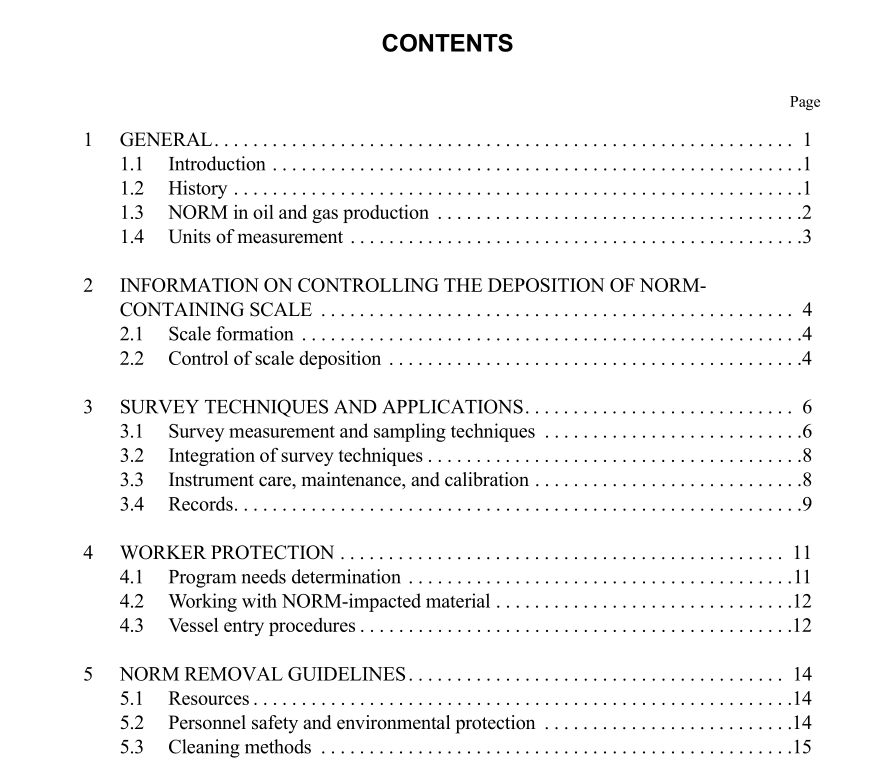API Bull E2 pdf download

API Bull E2 pdf download.Bulletin on Management of Naturally Occurring Radioactive Materials (NORM) in Oil and Gas Production
1.3 NORM IN OIL AND GAS PRODUCTION NORM
represents a wide range of materials that are radioactive in their natural state. These materials include carbon 14 and potassium 40, both of which are present in the human body. The radioactive elements of concern in oil and gas production occur naturally throughout the earth’s crust and are sometimes present in the formations from which oil and gas are produced. These ele- ments include uranium, thorium, and their respective progeny. The isotopes of concern are radium-226 (Ra-226), radium-228 (Ra-228) and their progeny (Appendix A). Small amounts of uranium are occasionally produced with the oil and gas. These elements, like other mineral elements, are present in oil and gas bearing formations in varying concentrations. Many oil and gas bearing reservoirs contain shales that may contain higher than average amounts of these radioactive elements. Depending on their solubility, these elements may find their way into production fluids since they are present in the formation. Many of the physical and chemical characteristics of oil and gas formations tend to increase the solubility of these elements in production fluids. When the radioactive elements are brought to the surface with the produced fluids, a number of changes can take place depending on the characteristics of the specific site. Usually the radioactive elements stay with the water phase of the production fluids and may either incorporate themselves in pipe scale (radium coprecipitated in barium sulfate), or precipitate into sludges. Formation of NORM scale occurs when radium substitutes for barium in barite scale, producing a coprecipitated (Ba, Ra)SO4 scale. Substi- tution of radium for calcium and strontium occurs in a similar manner. The ability of radium to substitute is due to the similarity in ionic radius, molecular size, and valence of the elements. The amount of substitution is often small, due to the higher abundance of barium in solution versus radium. Radon may be dissolved in produced water and/or oil and released at atmospheric pressure; however it usually follows the gas production steam. Since the boiling point of radon lies between that of ethane and propane, the highest levels of the longer-lived radon progeny, lead-210 (Pb-210), bismuth-210 (Bi-210), and polonium-210 (Po-210), are generally found in pumps, tanks and product lines associated with ethane/propane processing in gas operations. These radon progeny may also accumulate in gas pro- cessing equipment such as inlet filters and reflux pumps. The accumulations may be associated with a thin black film coating (fer- ric sulfide), a sludge (also known as pipe rouge), or a clean metal surface. It is important to note that accumulations of these types, e.g. ferric sulfide or sludge may not have any associated increased level of radioactivity. The affinity for the accumulations also varies. They may be easily removable (typically observed with sludge or pipe rouge) or require more aggressive techniques such as grinding. The formation of ferric sulfide in gas vessels is caused by the action of hydrogen sulfide on steel. Various NORM occurrence surveys have found significant concentrations of NORM in only a small percentage of oil and gas production operations. These facilities are generally limited to certain geographical areas: the Gulf Coast (from the Florida pan- handle to Brownsville, Texas), northeast Texas, southeast Illinois and southern Kansas. This suggests that operations located in those areas may have a higher probability of finding significant occurrences of NORM. This does not mean that NORM is absent in other locations. The only way to be sure that oil and gas operations do not have significant levels of NORM is to survey the site as detailed in Section 3.









